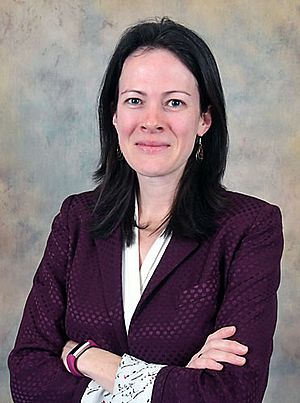Lindsay M. De Biase facts for kids
Quick facts for kids
Lindsay M. De Biase
|
|
|---|---|

De Biase in 2018
|
|
| Nationality | American |
| Alma mater | Yale University Johns Hopkins School of Medicine National Institute on Drug Abuse |
| Known for | Diversity of microglia in the brain parenchyma |
| Awards | 2019 Glen Foundation and American Foundation for Aging Research Grant, 2018 NARSAD Young Investigator Award, 2017 NIDA Women’s Science Advisory Committee, Excellence in Scientific Research Award |
| Scientific career | |
| Fields | Neuroscience, glial biology |
| Institutions | University of California, Los Angeles |
Lindsay M. De Biase is an American scientist who studies the brain. She is a neuroscientist and a glial biologist. Currently, she is a professor at the University of California, Los Angeles (UCLA).
Dr. De Biase studies tiny brain cells called microglia. She wants to understand how different types of microglia work in a part of the brain called the basal ganglia. Her goal is to find ways to treat brain diseases by targeting specific microglia. Her earlier work showed that microglia are not all the same throughout the brain.
Contents
Early Life and Education
Lindsay De Biase went to Yale University in New Haven, Connecticut. She studied how cells and molecules develop. In 2003, she earned her science degree.
After Yale, Dr. De Biase worked as a research assistant at the Children's National Hospital in Washington, D.C.. She looked at how genes change in a disease called amyotrophic lateral sclerosis (ALS). She also studied different types of immune cells.
In 2005, Dr. De Biase started her advanced studies at Johns Hopkins School of Medicine. She focused on neuroscience, which is the study of the nervous system and the brain. Her mentor was Dwight Bergles. She studied how neurons (brain cells that send signals) connect with other special cells called oligodendrocyte precursor cells (OPCs).
Discoveries About Brain Cells
Dr. De Biase first studied NG2+ oligodendrocyte progenitors in mouse brains. These cells later become oligodendrocytes, which help brain cells communicate. She found that these NG2+ cells could receive signals from neurons very early in development. This showed that OPCs can "listen in" on brain activity before they fully mature.
Her research showed that these OPCs have special connections, or synapses, with neurons. These connections allow OPCs to monitor what neurons are doing. This was a new discovery about how different brain cells interact during development.
Career and Research
After finishing her studies in 2011, Dr. De Biase did more research at the National Institute on Drug Abuse. She worked with Antonello Bonci. During this time, she made an important discovery: microglia are not all the same throughout the brain. This idea was different from what many scientists thought before. Her findings helped start her own research program.
In 2018, Dr. De Biase became a professor at the David Geffen School of Medicine at the University of California, Los Angeles. She leads her own lab, called the De Biase Lab.
Understanding Microglia in the Brain
The De Biase Lab focuses on understanding the different types of microglia in the basal ganglia. This part of the brain is important for movement and emotions. Dr. De Biase's research suggests that microglia might be specialized for different brain areas. This means that treatments for brain diseases could be made to target only the specific microglia involved.
Her lab uses advanced tools to study microglia. They use high-resolution imaging to see the cells up close. They also record the electrical activity of microglia and analyze their genes. This helps them learn how microglia work in different parts of the brain and how they change during disease.
Diversity of Microglia Types
Scientists used to think that all microglia in the brain were pretty much the same. But Dr. De Biase's work challenged this idea. She found that microglia look different, have different contents inside them, and act differently depending on where they are in the basal ganglia.
These differences in microglia start to appear when animals are very young, around two weeks old. The local environment in each brain area helps shape these differences. Her findings suggest that specific microglia types play important roles in how different brain circuits work.
Her team at UCLA also studied how microglia become specialized over time. They found that microglia numbers grow quickly in certain brain areas during the second and third weeks after birth. This rapid growth happens after microglia have spread evenly throughout the brain. Then, some microglia die off to reach adult levels. The regional differences in microglia start around day eight after birth. This suggests that microglia are very active in shaping brain circuits during this important time of development.
Awards and Honors
- 2019 Glen Foundation and American Foundation for Aging Research Grant for Junior Faculty
- 2018 NARSAD Young Investigator Award
- 2017 NIDA Postdoctoral Fellow Mentoring Award
- 2017 NIDA Women's Science Advisory Committee, Excellence in Scientific Research Award
- 2014-2016 Fellows Award for Research Excellence, NIH
- 2009 Robert Goodman Scholars Award, Johns Hopkins School of Medicine

